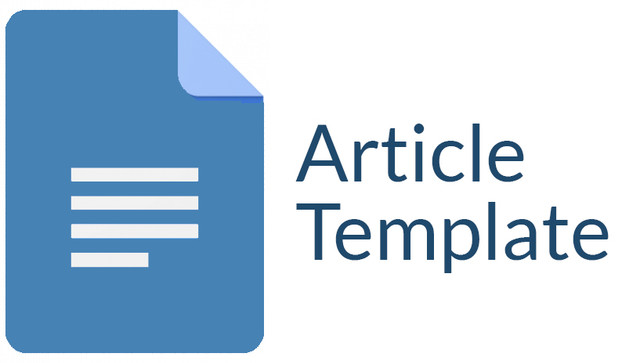Pengembangan Buku Ajar Matematika Berbasis Pendekatan Matematika Realistik
Keywords:
Textbook, Realistic Mathematics Approach, The Understanding Mathematic Of StudentAbstract
This study have objective to develop mathematics textbook based on realistic approach in the volume of cubes and blocks material to improve the understanding of grade V students SDN Bader 03 academic year 2020/2021which has valid and practical criteria. The type of research has used is Research and Development (R & D). Data collection techniques has used questionnaires, interviews, and tests. Data analysis technique has used is the criterion of BNSP 2007 textbook. The result of the research on the development of mathematics teaching book with this realistic approach can improve the understanding of grade V SDN Bader 03 students who have valid and practical, as evidenced by the validation of the experts for the eligibility of content with a value of 82.625, linguism of 81,150, presentation of 83,575, and graphical representation 83,983, with good category. As for the results of students' understanding tests get an average score of 80.125 that exceeds the existing KKM is 75. This proves that the development of textbooks based on realistic mathematics approach has a valid and practical criteria.
Downloads
References
Antonius. 2015. Buku Pedoman Guru. Bandung: Yrama Media.
Arikunto, Suharsimi. 2014. Prosedur Penelitian Suatu Pendekatan Praktik. Jakarta: PT Rineka Cipta.
Fathurrohman, Pupuh & Sutiknoi, Sobry. 2010. Strategi Belajar Mengajar. Bandung: PT Refika Aditama.
Huda, Miftahul. 2013. Model-Model Pengajaran Dan Pembelajaran. Yogyakarta: Pustaka Pelajar.
Johnson, Elaine B. 2010. CTL Contextual Teaching Dan Learning. Bandung: Kaifa.
Kosasih, E. 2015. Strategi Belajar Dan Pembelajaran Implementasi Kurikulum 2013. Bandung: Yrama Widya.
Majid, Abdul. 2009. Perencanaan Pemebelajaran. Bandung: PT Remaja Rosdakarya.
Mulyasa, E. 2010. Kurikulum Tingkat Satuan Pendidikan. Bandung: PT Remaja Rosdakarya.
Muslich, Masnur. 2012. KTSP (Kurikulum Tingkat Satuan Pendidikan) Dasar Pemahaman Dan Pengembangan. Jakarta: PT Bumi Aksara.
Marsini, M. (2023). The Effectiveness of the E-Library as a Learning Resource for Elementary School Students' Social Studies in Improving Literacy Skills. AL-ISHLAH: Jurnal Pendidikan, 15(3), 3726-3736.
Marsini, M. (2023). Motivasi Belajar Siswa pada Pembelajaran IPS di SDN Kraton VI Maospati. Jurnal Educatio FKIP UNMA, 9(1), 302-309.
Purwaningsih, L., Hadianti, A., & Marsini, M. (2022). PROTOTYPE DESIGN FLIPBOOK MEDIA IN TEACHING GRAMMAR “SIMPLE PAST TENSE”. Indonesian EFL Journal, 8(2), 287-294.
Prihatin, Eka. 2008. Guru Sebagai Fasilitator. Bandung: PT Karsa Mandiri Persada.
Rasyid, Harun & Mansur. 2011. Penilaian Hasil Belajar. Bandung: CV Wahana Prima.
Rosalin, Elin. 2008. Gagasan Merancang Pembelajaran Kontekstual. Bandung: PT Karsa Mandiri Persada.
Saefuddin, Asis & Berdiati, Ika. 2015. Pembelajaran Efektif. Bandung: PT Remaja Rosdakarya.
Sagala, Syaiful. 2014. Konsep Dan Makna Pembelajaran. Bandung: Alfabeta.
Sanjaya, Wina. 2013. Strategi Pembelajaran Berorientasi Standar Proses Pndidikan. Jakarta: Kencana.
Slameto. 2013. Belajar Dan Faktor-Faktor Yang Mempengaruhi. Jakarta: Rineka Cipta.
Sri, W. 2017. Pengembangan Lembar Kerja Siswa (LKS) Pada Materi Segiempat Dengan Pendekatan Pendidikan Matematika Realistik Indonesia (PMRI) di SMPN 2 Muara Sugihan. Skripsi tidak diterbitkan. Palembang. Program Studi Pendidikan Matematika Fakultas Ilmu Tarbiyah Dan Keguruan Universitas Islam Negeri Raden Fatah Palembang.
Sugiyono. 2015. Metode Penelitian Pendidikan. Bandung: ALFABETA.
Sukmadinata, Nana Syaodih. 2010. Metode Penelitian Pendidikan. Bandung: PT Remaja Rosdakarya.
Sundayana, Rostina. 2014. Media Dan Alat Peraga Dalam Pembelajaran Matematika. Bandung: Alfabeta
Supatmono, Catur. 2009. Matematika Asyik. Jakarta: PT Gramedia Widiasarana Indonesia.
Susanto, Ahmad. 2013. Teori Belajar Dan Pembelajaran Di Sekolah. Jakarta: Kencana.
Taruga, R. 2014. Pengembangan Perangkat Pembelajaran Matematika Materi Bangun Ruang Sisi Lengkung Dengan Model Pembelajaran Berbasis Masalah. Skripsi tidak diterbitkan. Yogyakarta. Program Studi Pendidikan Matematika Fakultas Ilmu Matematika Dan Ilmu Pengetahuan Alam Universitas Negeri Yogyakarta.
Uno, Hamzah B. 2012. Perencanaan Pembelajaran. Jakarta: Bumi Aksara.
Usman, Moh. Uzer. 2013. Menjadi Guru Profesional. Bandung: PT Remaja Rosdakarya.
Yamin, Martinis. 2013. Paradigma Baru Pembelajaran. Jakarta: Referensi.
Downloads
Published
Issue
Section
License

This work is licensed under a Creative Commons Attribution-ShareAlike 4.0 International License.
Authors who publish with this journal agree to the following terms:
1. Copyright on any article is retained by the author(s).
2. The author grants the journal, right of first publication with the work simultaneously licensed under a Creative Commons Attribution License that allows others to share the work with an acknowledgment of the work’s authorship and initial publication in this journal.
3. Authors are able to enter into separate, additional contractual arrangements for the non-exclusive distribution of the journal’s published version of the work (e.g., post it to an institutional repository or publish it in a book), with an acknowledgment of its initial publication in this journal.
4. Authors are permitted and encouraged to post their work online (e.g., in institutional repositories or on their website) prior to and during the submission process, as it can lead to productive exchanges, as well as earlier and greater citation of published work.
5. The article and any associated published material is distributed under the Creative Commons Attribution-ShareAlike 4.0 International License









